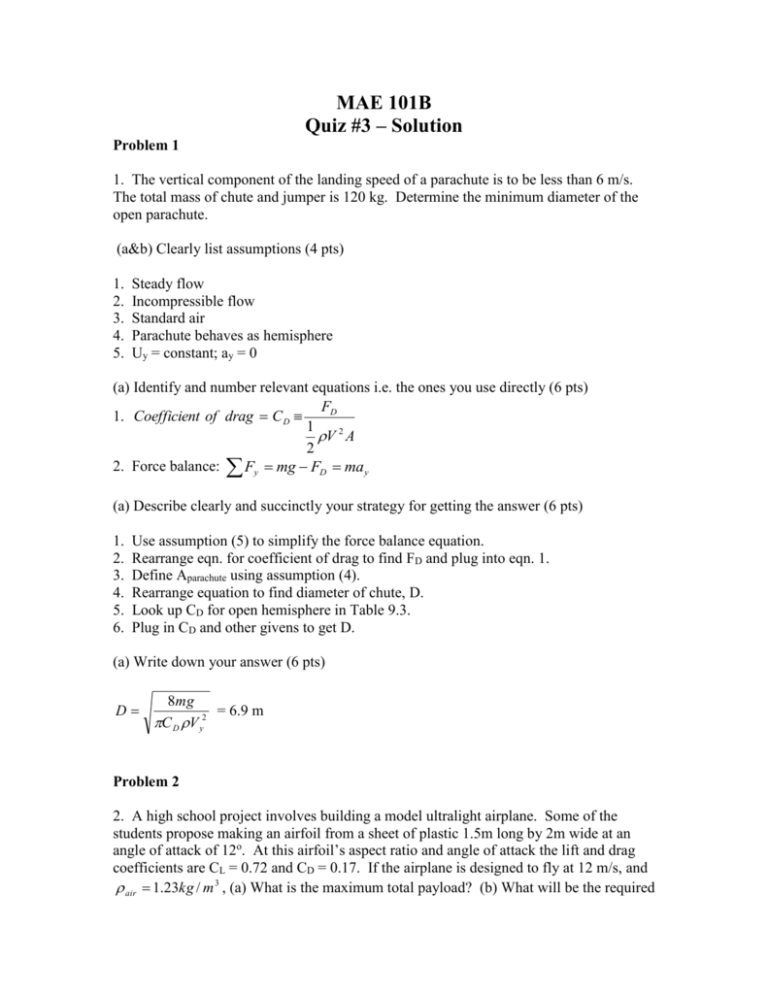quiz_3_soln.doc
advertisement

MAE 101B Quiz #3 – Solution Problem 1 1. The vertical component of the landing speed of a parachute is to be less than 6 m/s. The total mass of chute and jumper is 120 kg. Determine the minimum diameter of the open parachute. (a&b) Clearly list assumptions (4 pts) 1. 2. 3. 4. 5. Steady flow Incompressible flow Standard air Parachute behaves as hemisphere Uy = constant; ay = 0 (a) Identify and number relevant equations i.e. the ones you use directly (6 pts) FD 1. Coefficient of drag C D 1 V 2 A 2 2. Force balance: Fy mg FD ma y (a) Describe clearly and succinctly your strategy for getting the answer (6 pts) 1. 2. 3. 4. 5. 6. Use assumption (5) to simplify the force balance equation. Rearrange eqn. for coefficient of drag to find FD and plug into eqn. 1. Define Aparachute using assumption (4). Rearrange equation to find diameter of chute, D. Look up CD for open hemisphere in Table 9.3. Plug in CD and other givens to get D. (a) Write down your answer (6 pts) D 8mg = 6.9 m C D V y2 Problem 2 2. A high school project involves building a model ultralight airplane. Some of the students propose making an airfoil from a sheet of plastic 1.5m long by 2m wide at an angle of attack of 12o. At this airfoil’s aspect ratio and angle of attack the lift and drag coefficients are CL = 0.72 and CD = 0.17. If the airplane is designed to fly at 12 m/s, and air 1.23kg / m 3 , (a) What is the maximum total payload? (b) What will be the required power to maintain flight? (c) The pilot Brian Allen can sustain 0.39hp for 2 hours, could he power this lightweight plane? (a,b&c) Clearly list assumptions (4 pts) 1. Steady flow 2. Incompressible flow (a) Identify and number relevant equations i.e. the ones you use directly (6 pts) FL 1. Coefficient of lift C L 1 V 2 A 2 2. Force balance: FL = W (a) Describe clearly and succinctly your strategy for getting the answer (6 pts) 1. 2. 3. 4. Calculate the area by multiplying length x width. Using eqn. 1 find FL. Plug this into eqn. 2 for weight, where W = mg. Solve for mass knowing FL and g. (a) Write down your answer (6 pts) m C L V 2 lw 19.5kg 43lbs 2g (b) Identify and number relevant equations i.e. the ones you use directly (6 pts) FD 1. Coefficient of drag C D 1 V 2 A 2 2. Force balance: FD = Thrust (b) Describe clearly and succinctly your strategy for getting the answer (6 pts) 1. Using eqn. 1 find FD. 2. Plug this into eqn. 2 for Thrust. 3. Solve for Power knowing P = Thrust x Velocity. (b) Write down your answer (6 pts) P C D V 3lw 542W 0.727 hp 2 (c) Brian Allen could not power the plane because he does not output enough power, and he probably weighs too much! Problem 3 3. f Problem 4 4. a. False b. False c. False d. True e. True Problem 5 5. e Problem 6 6. e







